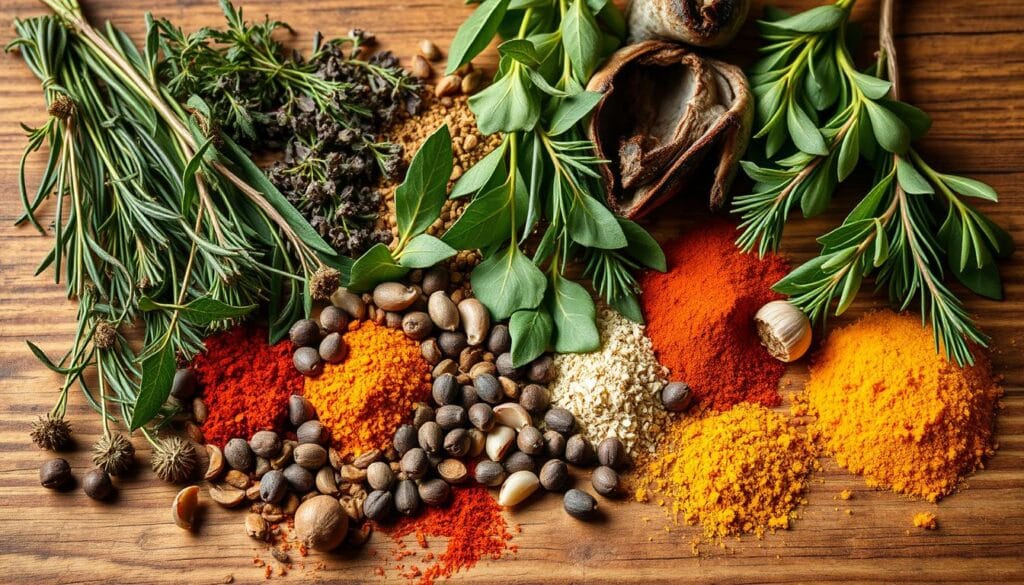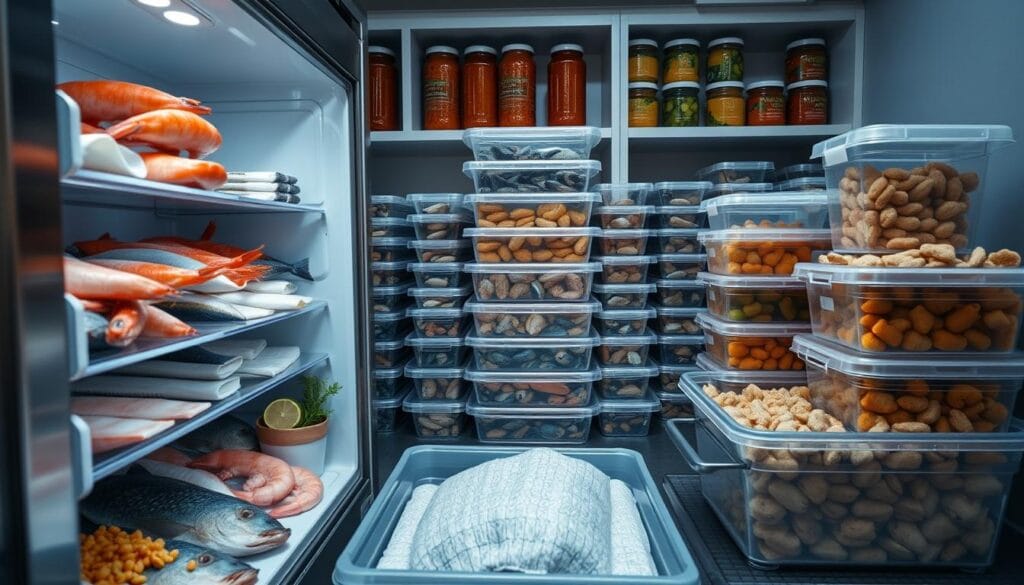Every kitchen has its own story, and seafood recipes take us on a journey to far-off places. The seafood tango is more than a meal; it’s a dance of flavors that honors Spanish sea traditions. Imagine you’re in your kitchen, with all your ingredients ready to make a dish that links you to the sea.
Preparing seafood tango is more than cooking; it’s diving into a tradition of taste, skill, and love. This elegant recipe lets you dive into Spanish cooking, turning simple ingredients into a dish that will wow your loved ones.
Table of Contents
What is Seafood Tango?
Seafood tango is a lively culinary experience that brings the taste of Spanish coastal cooking to life. It combines fresh ingredients with traditional cooking methods. This mix creates a burst of flavors that play on your taste buds.
Seafood tango is more than a recipe; it’s a celebration of the sea’s bounty. It highlights the importance of using sustainable seafood. The dish honors a long tradition of using fresh, local ingredients and precise cooking.
Roots of the Culinary Tradition
Seafood tango is inspired by the cooking of Spain’s coast. It connects to dishes like paella. Its roots are in the Mediterranean coastal areas, where seafood cooking is a cherished tradition passed down through generations.
- Rooted in Spanish coastal cooking traditions
- Emphasizes fresh, local seafood ingredients
- Reflects the vibrant culinary culture of Spain
Essential Ingredients
To make a true seafood tango, you need to pick the right ingredients. These should show off the natural taste of sustainable seafood. Your list might include:
- Fresh seafood (such as shrimp, mussels, or calamari)
- High-quality olive oil
- Aromatic herbs and spices
- Fresh vegetables
“Seafood tango is not just a meal, it’s a culinary journey that connects you to the rich maritime traditions of Spain.”
Choosing sustainable seafood means you’re enjoying a tasty meal and supporting good fishing practices. Each ingredient is key to the dish’s unique flavor profile.
Essential Cooking Techniques
Mastering seafood recipes needs precision and skill. Your journey into restaurant seafood dishes starts with basic cooking techniques. These techniques turn simple ingredients into amazing meals.
Cooking seafood requires attention to detail and careful preparation. The right techniques can make your dish go from good to great.
Sautéing Seafood with Precision
Sautéing is key for making tasty seafood dishes. Here are the main steps:
- Heat olive oil in a pan over medium-high heat
- Pat seafood dry with paper towels for better searing
- Season proteins with salt and pepper
- Cook for 2-3 minutes per side until golden brown
Preparing Perfect Accompaniments
Creating great side dishes for seafood takes thought. Here are tips for making side dishes like a pro:
- Choose light, fresh ingredients that complement the seafood
- Use herbs like parsley and basil for extra flavor
- Prepare side dishes at the same time as the main protein
- Go for balanced textures and temperatures
Pro tip: Timing is everything when cooking seafood. Make sure each part is perfectly cooked and served at its best.
Choosing the Right Seafood
Choosing the perfect seafood is key to a great seafood tango dish. Start by knowing the importance of quality and sustainability from the fresh seafood market.
- Freshness of the catch
- Nutritional value
- Environmental impact
- Flavor profile
Types of Seafood for Your Dish
Your seafood tango can be amazing with different types of seafood. Here are some top picks:
| Seafood Type | Recommended Serving | Nutrition Highlights |
|---|---|---|
| Salmon | 4 oz per serving | High in omega-3 fatty acids |
| Shrimp | 3-4 oz per serving | Low calorie, rich in protein |
| Scallops | 3 oz per serving | Excellent source of antioxidants |
| Cod | 4 oz per serving | Low mercury, lean protein |
Fresh vs. Frozen Options
Understanding fresh and frozen seafood is important. Fresh fish lasts only 2 to 3 days in the fridge. Frozen seafood, on the other hand, keeps longer and tastes consistent.
When choosing sustainable seafood, focus on:
- Locally sourced options
- Seasonal catches
- Certified sustainable seafood
- Minimal processing
Your seafood tango needs the best ingredients. By picking wisely from the fresh seafood market and knowing about sustainable seafood, you’ll make a dish that’s both delicious and eco-friendly.
Herbs and Spices for Flavor
To make a real seafood tango, you need to balance herbs and spices just right. The right mix can turn your seafood dishes into a feast for the senses. It brings the true taste of Spanish cuisine to life.

Spanish food is known for its bold and rich flavors. To get that special taste in your seafood tango, use these key seasonings:
- Smoked Paprika (Pimentón): The crown jewel of Spanish seasonings
- Saffron: Adds a luxurious golden color and unique flavor
- Garlic: A fundamental ingredient in most Spanish dishes
- Fresh herbs like parsley and oregano
Classic Spanish Seasonings
Smoked paprika is a must-have for seafood dishes. It comes in sweet and bittersweet types. The sweet variety is the best for flavor. It adds smokiness, color, and depth to your seafood tango.
“The secret to great Spanish cooking is understanding how to layer flavors.” – Spanish Culinary Expert
Tips for Balancing Flavors
When seasoning your seafood tango, keep these tips in mind:
- Start with small amounts of strong spices
- Taste as you go
- Let the seafood’s natural flavor shine through
- Use fresh herbs for brightness
Try different mixes to find your favorite seafood tango seasoning. The aim is to create a blend that boosts the seafood’s flavor without overpowering it.
Key Cooking Equipment
To make restaurant-quality seafood tango, you need the right tools. Professional chefs know that special equipment makes a big difference. The right kitchen setup is key to cooking tasty seafood dishes.
Must-Have Tools for Perfect Seafood Tango
Some tools are essential for cooking seafood tango. They make the process easier and more fun. Here are the must-haves for your kitchen:
- Large paella-style pan for authentic cooking
- Sturdy stainless steel spatula
- Digital cooking thermometer
- High-quality kitchen tongs
- Sharp chef’s knife
Equipment Alternatives for Home Cooks
You don’t need a special seafood tango pan to cook great dishes. Common kitchen tools can do the trick. A large skillet or wide sauté pan can be a good substitute for a paella pan.
Here are some alternatives if you’re missing specific tools:
- Cast iron skillet for even heat distribution
- Non-stick wide pan with high sides
- Deep stainless steel cooking pan
Pro tip: For those tasty rice bits called socarrat, get a carbon steel or traditional paella pan. These pans help get that crispy texture that makes your seafood tango stand out.
Preparing Your Seafood Tango
Mastering seafood tango needs precision and passion. It turns fresh seafood into a special dining experience. Your ceviche and paella will show off your skills with bright flavors and beautiful presentation.
Step-by-Step Cooking Instructions
Creating authentic seafood tango requires careful steps. Here’s what you need to do:
- Choose the best seafood for freshness and quality
- Prepare your ingredients with care and precision
- Marinate seafood in citrus and herbs
- Sauté ingredients at the right temperature
- Layer flavors carefully during cooking
Presentation Tips
Make your seafood tango stand out with these plating tips:
- Use white plates to show off colorful ingredients
- Arrange seafood in an artistic circular pattern
- Garnish with fresh herbs
- Drizzle finishing sauce around the dish
*”Cooking is an art, and presentation is its beautiful frame.”*
Your seafood tango will be more than just a meal. It will be a culinary masterpiece that takes diners to Spain’s coastal regions.
Pairing Side Dishes
Creating the perfect seafood tango experience is more than just the main dish. Your side dishes can make the meal go from good to great. The right sides will enhance the flavors of your seafood tango sushi or shrimp scampi.
Exciting Accompaniment Options
When picking side dishes, aim for balance in flavors and textures. You want a plate that lets the seafood shine. Here are some great choices:
- Coconut Rice: Adds a sweet, subtle backdrop
- Cucumber Dill Salad: Provides a fresh, crisp contrast
- Roasted Potatoes: Offers a hearty, earthy complement
- Quinoa Salad: Delivers a nutty, textured foundation
Flavor Balancing Techniques
The secret to great side dishes is knowing how to balance flavors. Your seafood tango shrimp scampi needs sides that boost its taste without overpowering it. A smart approach to pairing turns your meal into a journey of flavors.
| Side Dish | Flavor Profile | Best Paired With |
|---|---|---|
| Mango Salsa | Sweet and Tangy | Grilled Seafood Tango |
| Sautéed Spinach | Earthy and Rich | Seafood Tango Sushi |
| Pineapple Chutney | Sweet and Spicy | Blackened Seafood |
The aim is to have a balanced plate where each part is a star. Your seafood tango should have sides that add to its taste without taking over.
Storing Leftovers
Keeping your seafood tango’s flavors fresh is key. Whether it’s a tasty seafood recipe or a salmon teriyaki dish, storing leftovers right is important. It helps keep the quality and taste up.

First, cool your seafood tango fast. Vacuum sealing is great for keeping leftovers fresh. It stops bacteria from growing.
Best Storage Practices
- Cool seafood to room temperature within 2 hours of cooking
- Store in airtight containers or vacuum-sealed bags
- Refrigerate promptly at or below 40°F
- Use within 1-2 days for optimal flavor and safety
Smart Reheating Tips
Reheating seafood tango needs care to avoid overcooking. Here are some tips:
- Remove seafood from refrigerator 30 minutes before reheating
- Use low, gentle heat to warm through
- Add a splash of water or broth to maintain moisture
- Avoid microwave if possible – stovetop works best
Pro tip: Turn leftover seafood tango salmon teriyaki into a fresh salad or quick pasta dish. It’s a new meal without waste.
Bringing It All Together
Creating the perfect seafood tango takes practice and passion. Your journey to becoming a home chef starts with understanding Spanish cuisine. See each cooking experience as a chance to improve and find your unique style.
When making seafood tango, details matter a lot. Focus on the quality of your ingredients, cooking temperatures, and seasoning. Chefs say using fresh seafood and precise cooking times is key to keeping flavors and textures right.
Tips for Perfecting Your Technique
Choose the best ingredients to bring out the true flavors of your seafood tango. Use mise en place to organize your ingredients before cooking. Start with small portions to build your confidence, then move on to more complex dishes.
Hosting a Seafood Tango Dinner Party
When hosting a seafood tango dinner, make your space welcoming. Think about making parts of your dish ahead of time to relax during your guests’ visit. Pair your dish with sides that complement its flavors, making your meal unforgettable.

